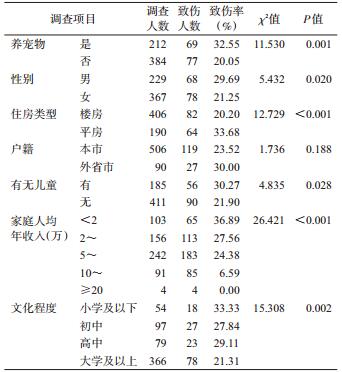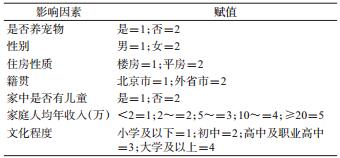
扩展功能
文章信息
- 周冰, 曹殿起, 付慧英, 刘缘, 史文静, 彭素标
- ZHOU Bing, CAO Dian-qi, FU Hui-ying, LIU Yuan, SHI Wen-jing, PENG Su-biao
- 北京市门头沟区常住居民动物伤害现况及影响因素调查
- An investigation of current status and influencing factors of animal-induced injuries in permanent residents in Mentougou district, Beijing, China
- 中国媒介生物学及控制杂志, 2020, 31(5): 619-622
- Chin J Vector Biol & Control, 2020, 31(5): 619-622
- 10.11853/j.issn.1003.8280.2020.05.024
-
文章历史
- 收稿日期: 2020-04-16
2 北京市东城区疾病预防控制中心, 北京 100009
2 Dongcheng Center for Disease Control and Prevention of Beijing
近年来动物伤人事件时有发生,其中宠物伤人事件也屡见不鲜[1-4]。门头沟区狂犬病暴露处置门诊每年接诊数千人,宠物伤害在动物伤人事件中占90%以上[5-6]。为了解门头沟区常住居民动物伤害现状、伤口处置情况,为制定动物相关传染病防控策略、减少动物伤害提供科学依据,我们于2018年2-8月对门头沟区居民开展了动物伤害现状调查,结果报告如下。
1 对象与方法 1.1 抽样方法北京市门头沟区有13个乡镇办事处,按照山区、城区和城乡结合部分为3类,每类随机抽取1个镇,每镇随机抽取2个村(居),山区和城乡结合部每村(居)随机抽取100户,每个城镇村(居)随机抽取110户,共抽取样本620户。每户抽取1名成年人经其知情同意后参与调查。
1.2 动物伤害动物伤害指曾被各种动物致伤、皮肤黏膜等有破损。宠物致伤指伤人动物为有主动物。
1.3 统计学分析采用EpiData 3.2软件建立数据库,统计分析使用SPSS 22.0软件,用描述性统计方法描述动物伤害现状,率的比较采用χ2检验,多因素分析使用logistic回归。P<0.05为差异有统计学意义。
2 结果 2.1 基本情况共发出问卷620份,收回有效问卷596份,有效率为96.13%(596/620)。被调查者中男性占38.42%(229/596),女性占61.58%(367/596)。其中本市户籍占84.73%(505/596),外地户籍占15.27%(91/596)。被调查户中宠物饲养率为35.57%(212/596)。
2.2 动物伤人情况被调查的596人中,146人曾被动物致伤,占24.50%(146/596)(表 1)。29人致伤时间为1年以内,占被调查总人数的4.87%(29/596)。将是否被致伤作为因变量,将是否养宠物、性别、户籍、住房类型、家庭中是否有儿童、家庭人均年收入和文化程度为自变量进行logistic回归分析,变量赋值见表 2。结果显示,家中饲养宠物、住平房、家中有儿童、外地户籍、收入低和文化程度低的人被动物致伤的比例更高。见表 3。

|

|

|
被动物致伤的146人中,135人被宠物致伤,占92.47%(135/146)。其中65人被自己饲养的宠物致伤,占44.52%(65/146);70人被他人饲养宠物致伤,占47.95%(70/146);11人被无主动物致伤,占7.53%(11/146)。在伤人动物种类上,105人被犬致伤,占71.92%(105/146);40人被猫致伤,占27.40%(40/146);1人致伤动物为乌龟,占0.68%(1/146)。
2.4 动物致伤者的疫苗免疫情况及未免疫原因仅111人被动物致伤后接种了疫苗,占致伤总人数的76.03%(111/146);23人认为伤口不严重,没必要接种疫苗,占致伤人数的15.76%(23/146);7人认为家里养的猫或者犬很干净,不带狂犬病病毒,占致伤人数的4.80%(7/146);2人认为自己免疫力好,不用接种疫苗,占1.37%(2/146);1人认为疫苗太贵,1人认为致伤动物打过疫苗不用接种,1人致伤动物为乌龟不用接种,各占0.68%(1/146)。
3 讨论从调查结果看,被调查者有24.50%曾被动物致伤,且92.47%的伤者被宠物致伤,说明动物致伤在普通居民中非常常见,而宠物又是最主要的致伤动物,与狂犬病暴露处置门诊接诊情况相一致[5-9]。而门头沟区犬只免疫率仅75.00%左右,考虑到有流浪动物存在,尚不能认为犬只免疫率能达到阻断狂犬病流行的程度,因此被犬、猫等危险动物致伤的患者都应该进行狂犬病疫苗免疫接种,宠物致伤给门头沟区居民带来了很大的经济和社会负担。
狂犬病一旦发病,病死率几乎为100%,接种疫苗是预防该病最有效的办法[10-13]。但是被动物致伤的患者对狂犬病疫苗注射的重要性认识远远不够,仅76.03%的被致伤者接种过疫苗,相当多的人存在侥幸心理,以伤口不严重、家养的动物不脏、自己免疫力好等理由不接种疫苗,留下了很大的免疫空白,存在重大安全隐患。门头沟区出现过的2例狂犬病病例都是被自己家宠物犬咬伤且未接种疫苗[5-6],其他相关研究也表明,绝大部分人狂犬病病例没有疫苗免疫史[14-16]。世界卫生组织狂犬病专家咨询委员会建议[13],对于狂犬病病毒Ⅲ级暴露者,应在接种疫苗的同时对伤口周围浸润注射被动免疫制剂,而门头沟区Ⅲ级暴露患者的被动免疫制剂应用率仅为66.67%[5-6]。
根据调查结果,家中饲养宠物、住平房、家中有儿童、外地户籍、收入较低和文化程度较低的人被动物致伤的比例更高,是狂犬病知识宣传的重点人群。我们提出以下建议:(1)加强宣传力度,提高宠物饲养者为宠物免疫接种的意识,提高普通群众对狂犬病的认识,提高群众对狂犬病疫苗接种和被动免疫制剂应用的正确认识。(2)加强动物管理,提高犬只免疫率,加强流浪动物管理。(3)转变狂犬病防控工作模式,由给人接种疫苗向增强动物免疫转变。
| [1] |
李春宵. 城市居民宠物饲养存在问题与对策[J]. 中国畜禽种业, 2018, 14(7): 36. Li CX. Problems and countermeasures in pet keeping of urban residents[J]. Chin Livestock Poult Breed, 2018, 14(7): 36. DOI:10.3969/j.issn.1673-4556.2018.07.024 |
| [2] |
徐褚, 赵海云. 宠物犬饲养管理不当的危害及防控措施[J]. 山东畜牧兽医, 2018, 39(2): 72-73. Xu C, Zhao HY. Harm and control measures of improper management of pet dog raising[J]. Shandong J Anim Sci Vet Med, 2018, 39(2): 72-73. DOI:10.3969/j.issn.1007-1733.2018.02.047 |
| [3] |
茅蓉, 金安宝, 顾伟玲. 浙江省嘉兴市2011-2016年犬伤门诊Ⅲ级暴露者特征与预防处置影响因素分析[J]. 中国媒介生物学及控制杂志, 2018, 29(4): 373-378. Mao R, Jin AB, Gu WL. Analysis on characteristics and influence factors of prevention and treatment of grade Ⅲ rabies exposure population at rabies clinic of Jiaxing, Zhejiang province 2011-2016[J]. Chin J Vector Biol Control, 2018, 29(4): 373-378. DOI:10.11853/j.issn.1003.8280.2018.04.014 |
| [4] |
赵敏. 浅析陕西省狂犬病防控措施及存在的问题和对策[J]. 畜禽业, 2019, 30(7): 109-110. Zhao M. The problems and countermeasures of the prevention and control measures of rabies in Shaanxi province[J]. Lives Poult Ind, 2019, 30(7): 109-110. DOI:10.19567/j.cnki.1008-0414.2019.07.087 |
| [5] |
周冰, 徐阳, 张一华, 等. 2010-2016年北京市门头沟区狂犬病暴露病例流行病学特征[J]. 职业与健康, 2017, 33(17): 2359-2362. Zhou B, Xu Y, Zhang YH, et al. Epidemiological characteristics of rabies exposure cases in Mentougou district of Beijing from 2010-2016[J]. Occup Health, 2017, 33(17): 2359-2362. DOI:10.13329/j.cnki.zyyjk.2017.0705 |
| [6] |
周冰, 彭素标. 北京市门头沟区2010-2013年狂犬病监测结果分析[J]. 中国媒介生物学及控制杂志, 2015, 26(3): 299-302. Zhou B, Peng SB. Surveillance of human rabies in Mentougou district of Beijing during 2010-2013[J]. Chin J Vector Biol Control, 2015, 26(3): 299-302. DOI:10.11853/j.issn.1003.4692.2015.03.020 |
| [7] |
张英, 印庆华, 杨玲玲. 上海市嘉定区35253例狂犬病暴露病例流行病学分析[J]. 中国临床医学, 2019, 26(2): 315-317. Zhang Y, Yin QH, Yang LL. Epidemiological analysis of 35253 cases of rabies exposure in Jiading district of Shanghai[J]. Chin J Clin Med, 2019, 26(2): 315-317. DOI:10.12025/j.issn.1008-6358.2019.20190205 |
| [8] |
王青海, 王旭, 王倩, 等. 北京市西城区2010-2017年狂犬病暴露人群流行病学特征分析[J]. 中国生物制品学杂志, 2019, 32(2): 165-168. Wang QH, Wang X, Wang Q, et al. Epidemiological characters of population exposed to rabies in Xicheng district, Beijing during 2010-2017[J]. Chin J Biol, 2019, 32(2): 165-168. DOI:10.13200/j.cnki.cjb.002466 |
| [9] |
安洲, 王斐, 李笑梅, 等. 安徽省芜湖市2014年狂犬病暴露处置监测分析[J]. 中国媒介生物学及控制杂志, 2018, 29(6): 641-644. An Z, Wang F, Li XM, et al. Analysis of rabies post-exposure treatment surveillance in Wuhu city in 2014[J]. Chin J Vector Biol Control, 2018, 29(6): 641-644. DOI:10.11853/j.issn.1003.8280.2018.06.024 |
| [10] |
周宏鹏, 刘拥军, 张秀娟, 等. 全球狂犬病流行现状及防治策略[J]. 中国动物检疫, 2015, 32(1): 50-52. Zhou HP, Liu YJ, Zhang XJ, et al. Global epidemic situation and elimination strategies of rabies[J]. Chin Anim Health Inspect, 2015, 32(1): 50-52. DOI:10.3969/j.issn.1005-944X.2015.01.019 |
| [11] |
王辉, 仇杰, 王宇红, 等. 2016-2018年兰州市狂犬病暴露人群流行病学分析[J]. 现代预防医学, 2019, 46(13): 2310-2313, 2354. Wang H, Qiu J, Wang YH, et al. Epidemiological analysis of rabies exposed population in Lanzhou, 2016-2018[J]. Mod Prev Med, 2019, 46(13): 2310-2313, 2354. |
| [12] |
佟丽, 王传林, 张怡滨, 等. 我国狂犬病暴露后"2-1-1"免疫程序研发及应用分析[J]. 中国急救复苏与灾害医学杂志, 2018, 13(11): 1156-1158. Tong L, Wang CL, Zhang YB, et al. Development and application of "2-1-1" immune program after rabies exposure in China[J]. Chin J Emerg Resusc Disaster Med, 2018, 13(11): 1156-1158. DOI:10.3969/j.issn.1673-6966.2018.11.030 |
| [13] |
王传林, 殷文武. 世界卫生组织2018年狂犬病疫苗立场文件解读[J]. 中国急救复苏与灾害医学杂志, 2018, 13(11): 1039-1050. Wang CL, Yin WW. Interpretation of World Health Organization rabies vaccine position paper in 2018[J]. Chin J Emerg Resusc Disaster Med, 2018, 13(11): 1039-1050. DOI:10.3969/j.issn.1673-6966.2018.11.004 |
| [14] |
唐金芳, 陆婉珠, 梁灵芝, 等. 2005-2017年南宁市狂犬病流行病学特征及潜伏期影响因素分析[J]. 实用预防医学, 2019, 26(6): 667-671. Tang JF, Lu WZ, Liang LZ, et al. Epidemiological characteristics of human rabies and factors affecting its incubation period in Nanning city, 2005-2017[J]. Pract Prev Med, 2019, 26(6): 667-671. DOI:10.3969/j.issn.1006-3110.2019.06.008 |
| [15] |
李艳丽, 刘晓强, 杨海涛, 等. 2005-2017年云南省狂犬病流行病学特征分析[J]. 疾病监测, 2018, 33(12): 1014-1017. Li YL, Liu XQ, Yang HT, et al. Analysis on rabies epidemiology in Yunnan province, 2005-2017[J]. Dis Surveill, 2018, 33(12): 1014-1017. DOI:10.3784/j.issn.1003-9961.2018.12.011 |
| [16] |
李晓梅, 张雪春, 卢莉. 北京市2005-2012年狂犬病流行特征分析[J]. 现代预防医学, 2014, 41(12): 2119-2121. Li XM, Zhang XC, Lu L. Analysis on the epidemiological characteristics of human rabies from 2005 to 2012 in Beijing[J]. Mod Prev Med, 2014, 41(12): 2119-2121. |
 2020, Vol. 31
2020, Vol. 31



